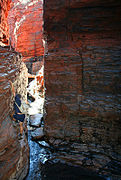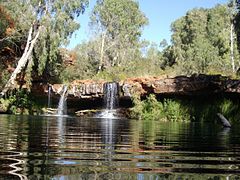Karijini National Park
| Karijini National Park | ||
|---|---|---|
| Eastern entrance | ||
|
|
||
| Location: | Western Australia , Australia | |
| Specialty: | Table mountains and gorges | |
| Next city: | Tom Price - Newman - Port Hedland | |
| Surface: | 6,274 km² | |
| Founding: | 1969 | |
| Address: | Karijini National Park PO Box 29 Tom Price WA 6751 Tel. (08) 9189 8157 |
|
In the Hamersley Range , in the center of the Pilbara , lies the extensive Karijini National Park (English Karijini National Park ; formerly Hamersley National Park ). It offers a spectacular, rugged backdrop in an ancient geological formation. With 627,445 hectares, it is the second largest national park in Western Australia . The dry, dusty steppe of the high plateau is criss-crossed by winding rivers, which suddenly plunge into gorges up to 100 m deep and fill basins in which the water provides an amazing flora and fauna . It can be reached from Port Hedland via the Great Northern Highway 326 km to the south or from the North West Coastal Highway on the west coast 345 km via Tom Price to the east. The access roads are asphalted, while the national park roads are gravel roads suitable for cars. The southern half of the national park is largely undeveloped. Tourism is limited to the gorges in the northern part. Mount Meharry is the highest mountain in the national park at 1,245 m.
Aboriginal people in the Karijini
The Banyjima, Yinhawangka and Kurrama Aborigines call the Hamersley Range Karijini . The name of the park pays tribute to the history and importance of the area to them, as well as their involvement in park management.
Evidence of their ancestors' presence dates back more than 20,000 years. During this time they also shaped nature and helped determine today's biodiversity of plants and animals.
climate
Located north of the Tropic of Capricorn, the climate can best be described as that of a tropical semi-desert. Strongly fluctuating amounts of precipitation, especially summer rain of 250–350 mm, are accompanied by thunderstorms and cyclones. Temperatures in summer are often over 40 ° C. The winter days are warm and clear, but the nights are cool and sometimes frosty.
geology
The streaky formations, found in the rock in and on the gorges, were formed more than 2.5 billion years ago when iron and silicate-rich sediment was deposited and accumulated on the sea floor. Over millions of years these iron-rich deposits were compacted into solid rock by the pressure of the overlying layers. Horizontal pressure later caused curvatures in the rock and formed numerous vertical crevices before it was lifted and become mainland. Rivers cut quickly and deeply into the land, creating steep-walled canyons. Combined with millions of years of erosion, they shaped this hilly landscape, criss-crossed by deep gorges.
The ravines
In the north of the national park, narrow river beds meander, hidden between mountain ranges and dried out for most of the year, only to suddenly plunge into narrow gorges up to 100 m deep. Further downstream, the gorges widen and their sides change from steep cliffs to sloping slopes with loose rock. The runoffs form the alluvial fan of the Fortescue Valley . The gorges contrast with the dry savannah above. They offer a grandiose backdrop with waterfalls, pools and the play of colors on the rock walls, caused by the minerals iron , copper and asbestos .
- Dales Gorge with Fortescue Falls, Fern Pool and Circular Pool
- the connected canyon system Hancock Gorge, Joffre Gorge, Weano Gorge, Knox Gorge, Red Gorge
- Hammersley Gorge
- Kalamina Gorge
- Yampire Gorge (contaminated with asbestos)
Flora and fauna
The wildflowers in the national park vary according to the season, but they grow in abundance after the rare rainfall. In the cooler months, the land is covered with countless yellow-blooming senna ( cassia ), acacia species, Mertensia paniculata and purple mulla mullas . In between live the red giant kangaroo , mountain kangaroo , Rothschild rock kangaroo , the dingo and various small animal species, including species of bats . Many species of native rodents and pouch predators, such as the pilbara niguai, are nocturnal and shy. Also reptiles and amphibians , such as frogs, geckos , lizards , agama , lizards , pythons and other snake species are located in the National Park. Many species of birds can be found near the basins and rivers. Australian mice , on the other hand, find shelter in the stony embankments. Finally, the large termite mounds are hard to miss, which are scattered between the hills in the grassland.
photos
Web links
- Karijini National Park (German)










